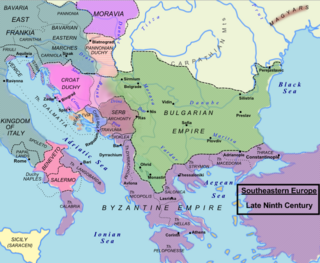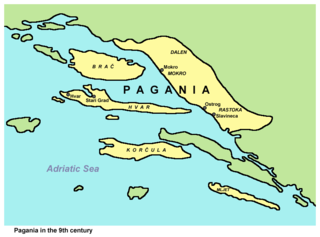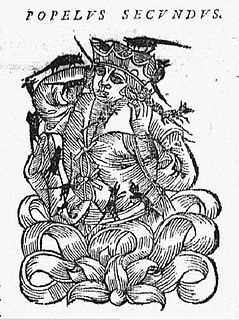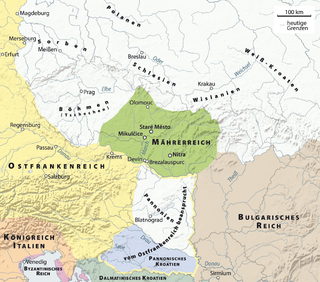 W
WBořivoj I was the first historically documented Duke of Bohemia and progenitor of the Přemyslid dynasty. His reign over the Duchy of Bohemia is believed to have started about the year 870, but in this era Bohemia was subordinated to Great Moravia. One of the most important clues to the approximate time of his accession is the contemporary Frankish chronicle Annales Fuldenses, which mentions several West Slavic princes in the year 872, among them one Goriwei, who may be identical with Bořivoj.
 W
WBorna was the Duke of Croatia from c. 810 to 821 and vassal of the Frankish Empire. He resided in Nin and was the ruler of most of the Croats in northern Dalmatia.
 W
WDervan or Derwan was an early King of the Sorbs.
 W
WDomagoj was Duke of Croatia from 864 to 876, and the founder of the Domagojević dynasty. He usurped the Croatian throne after the death of Trpimir I and expelled his sons. He took a more active role in the Adriatic Sea than his predecessors, encouraged the use of force and waged many wars, specifically with the Arabs, Venice and the East Francia. Domagoj's belligerence and the tolerance and support of piracy caused bad relations with Pope John VIII, which was further worsened after Domagoj showed no mercy to his conspirators. Formally a Frankish vassal, he used to his advantage the Frankish succession crisis and started a successful revolt against Carloman of Bavaria. After his death in 876, Domagoj was succeeded by his son who was deposed and expelled by Zdeslav in 878.
 W
WGojnik Vlastimirović or Gojnik of Serbia was a Serbian Župan who was subject to his elder brother Mutimir, the Grand Župan of the Serbian lands (Rascia) from ca. 850-860 with his brother Strojimir. He was the youngest son of Vlastimir of Serbia, the first independent ruler of Rascia.
 W
WPetar Gojniković or Peter of Serbia was Prince of the Serbs from 892 to 917. He ruled and expanded the First Serbian Principality (Rascia), and won several wars against other family members that sought the crown. He was the first Serbian monarch with a Christian (non-Slavic) name.
 W
WPrzemysław (Premislaus), after coronation Leszko I, was a legendary ruler of Poland, a goldsmith by trade and soldier who strategically defeated the Hungarians and thus was crowned. He was mentioned by bishop Wincenty Kadłubek (1161–1223) in the Chronica seu originale regum et principum Poloniae (1190–1208). 18th-century historiography dated him to 750 AD, 760–780, or between 750 and 776. James Anderson (1680–1739) claimed he ruled for 20 years.
 W
WLjudevit or Liudewit, was the Duke of Pannonian Croatia from 810 to 823. The capital of his realm was in Sisak. As the ruler of the Pannonian Slavs, he led a resistance to Frankish domination. Having lost the war against Franks, he fled to Ljudemisl, Borna's uncle, who treacherously killed him.
 W
WThe Narentines were a South Slavic tribe that occupied an area of southern Dalmatia centered at the river Neretva, active in the 9th and 10th centuries, noted as pirates on the Adriatic. Named Narentani in Venetian sources, Greek sources call them Paganoi, "pagans", as they were for long pagan, in a time when neighbouring tribes were Christianized. The tribe were fierce enemies of the Republic of Venice, having attacked Venetian merchants and clergy passing on the Adriatic, and even raided close to Venice itself, as well as defeated the Doge several times. Venetian–Narentine peace treaties did not last long, as the Narentines quickly returned to piracy. They were finally defeated in a Venetian crackdown at the turn of the 10th century and disappeared from sources by the 11th century.
 W
WMojmir I, Moimir I or Moymir I was the first known ruler of the Moravian Slavs (820s/830s–846) and eponym of the House of Mojmir. In modern scholarship, the creation of the early medieval state known as Great Moravia is attributed either to his or to his successors' expansionist policy. He was deposed in 846 by Louis the German, king of East Francia.
 W
WMojmir II was a member of the House of Mojmir and since 894 the last known ruler of Great Moravia. He probably died in the beginning of the 10th century in a battle against the Magyars.
 W
WThe Narentines were a South Slavic tribe that occupied an area of southern Dalmatia centered at the river Neretva, active in the 9th and 10th centuries, noted as pirates on the Adriatic. Named Narentani in Venetian sources, Greek sources call them Paganoi, "pagans", as they were for long pagan, in a time when neighbouring tribes were Christianized. The tribe were fierce enemies of the Republic of Venice, having attacked Venetian merchants and clergy passing on the Adriatic, and even raided close to Venice itself, as well as defeated the Doge several times. Venetian–Narentine peace treaties did not last long, as the Narentines quickly returned to piracy. They were finally defeated in a Venetian crackdown at the turn of the 10th century and disappeared from sources by the 11th century.
 W
WPrince Popiel ІІ was a legendary 9th century ruler of the West Slavic ("proto-Polish") tribe of Goplans and Polans and the last member of the pre-Piast dynasty, the Popielids. According to the chroniclers Gallus Anonymus, Jan Długosz, and Marcin Kromer, as a consequence of his bad rule he was deposed, besieged by his subjects, and eaten alive by mice in a tower in Kruszwica.
Pribina was a Slavic prince whose adventurous career, recorded in the Conversion of the Bavarians and the Carantanians, illustrates the political volatility of the Franco–Slavic frontiers of his time. Pribina was the first ruler of Slavic origin to build a Christian church on Slavic territory in Nitra, and also the first to accept baptism.
 W
WRastislav or Rostislav, also known as St. Rastislav, was the second known ruler of Moravia (846–870). Although he started his reign as vassal to Louis the German, king of East Francia, he consolidated his rule to the extent that after 855 he was able to repel a series of Frankish attacks. Upon his initiative two brothers, Cyril and Methodius. sent by the Byzantine Emperor Michael III in 863, translated the most important Christian liturgical books into Slavonic. Rastislav was dethroned by his nephew Svatopluk I of Moravia, who handed him over to the Franks.
 W
WRatimir was a Croatian duke or prince (knez) that ruled the Duchy of Pannonian Croatia between ca. 829 to 838. His name contents the word "rat", meaning "war", and "mir", meaning "peace". It is believed that Ratimir descends from a royal dynasty that provided rulers for Moravia and Croatia.
 W
WSpytihněv I, a member of the Přemyslid dynasty, was Duke of Bohemia from 894 or 895 until his death.
 W
WStrojimir was the co-ruler of the Serbian Principality alongside his two brothers Mutimir and Gojnik, from ca 851 to his and Gojnik's deposition in the 880s after an unsuccessful coup against the eldest Prince Mutimir.
 W
WSvatopluk I or Svätopluk I, also known as Svatopluk the Great, was a ruler of Great Moravia, which attained its maximum territorial expansion during his reign.
 W
WSvatopluk II or Svätopluk II was a member of the House of Mojmír and Prince in Moravia from 894 to 899, as which he strove to control all of Great Moravia.
 W
WTrpimir I was a duke in Croatia from around 845 until his death in 864. He is considered the founder of the Trpimirović dynasty that ruled in Croatia, with interruptions, from around 845 until 1091. Although he was formally vassal of the Frankish Emperor Lothair I, Trpimir used Frankish-Byzantine conflicts to rule on his own.
 W
WThe Narentines were a South Slavic tribe that occupied an area of southern Dalmatia centered at the river Neretva, active in the 9th and 10th centuries, noted as pirates on the Adriatic. Named Narentani in Venetian sources, Greek sources call them Paganoi, "pagans", as they were for long pagan, in a time when neighbouring tribes were Christianized. The tribe were fierce enemies of the Republic of Venice, having attacked Venetian merchants and clergy passing on the Adriatic, and even raided close to Venice itself, as well as defeated the Doge several times. Venetian–Narentine peace treaties did not last long, as the Narentines quickly returned to piracy. They were finally defeated in a Venetian crackdown at the turn of the 10th century and disappeared from sources by the 11th century.
 W
WVišeslav was one of the first dukes in Dalmatian Croatia.
 W
WVlastimir was the Serbian prince from c. 830 until c. 851. Little is known of his reign. He held Serbia during the growing threat posed by the neighbouring, hitherto peaceful, Bulgarian Khanate, which had expanded significantly toward Serbia.